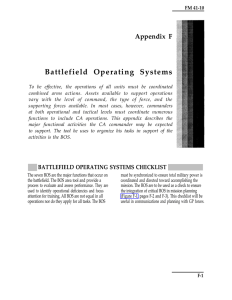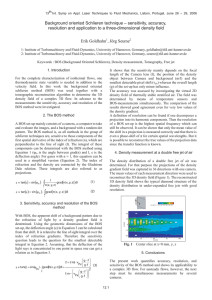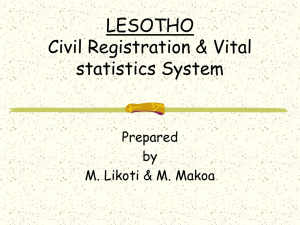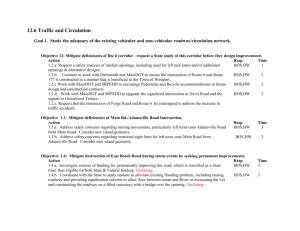IMPLICATIONS OF BURST OSCILLATIONS FROM THE SLOWLY ROTATING ACCRETING PULSAR IGR
advertisement
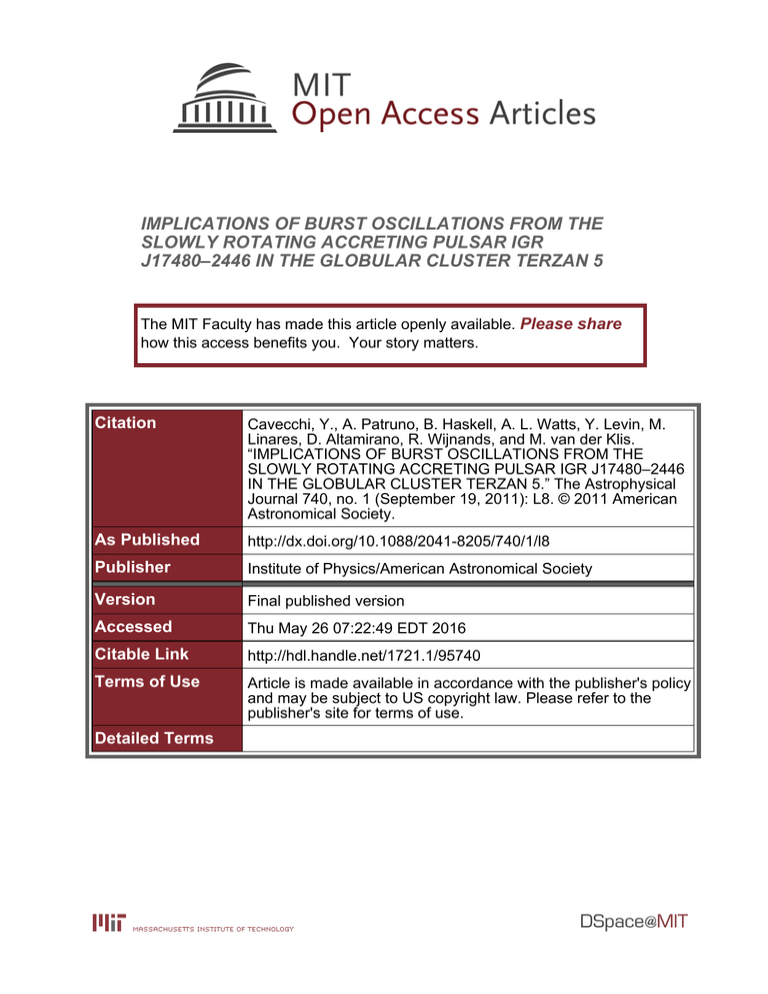
IMPLICATIONS OF BURST OSCILLATIONS FROM THE SLOWLY ROTATING ACCRETING PULSAR IGR J17480–2446 IN THE GLOBULAR CLUSTER TERZAN 5 The MIT Faculty has made this article openly available. Please share how this access benefits you. Your story matters. Citation Cavecchi, Y., A. Patruno, B. Haskell, A. L. Watts, Y. Levin, M. Linares, D. Altamirano, R. Wijnands, and M. van der Klis. “IMPLICATIONS OF BURST OSCILLATIONS FROM THE SLOWLY ROTATING ACCRETING PULSAR IGR J17480–2446 IN THE GLOBULAR CLUSTER TERZAN 5.” The Astrophysical Journal 740, no. 1 (September 19, 2011): L8. © 2011 American Astronomical Society. As Published http://dx.doi.org/10.1088/2041-8205/740/1/l8 Publisher Institute of Physics/American Astronomical Society Version Final published version Accessed Thu May 26 07:22:49 EDT 2016 Citable Link http://hdl.handle.net/1721.1/95740 Terms of Use Article is made available in accordance with the publisher's policy and may be subject to US copyright law. Please refer to the publisher's site for terms of use. Detailed Terms The Astrophysical Journal Letters, 740:L8 (5pp), 2011 October 10 C 2011. doi:10.1088/2041-8205/740/1/L8 The American Astronomical Society. All rights reserved. Printed in the U.S.A. IMPLICATIONS OF BURST OSCILLATIONS FROM THE SLOWLY ROTATING ACCRETING PULSAR IGR J17480−2446 IN THE GLOBULAR CLUSTER TERZAN 5 1 Y. Cavecchi1,2 , A. Patruno1 , B. Haskell1 , A. L. Watts1 , Y. Levin2,3 , M. Linares4 , D. Altamirano1 , R. Wijnands1 , and M. van der Klis1 Astronomical Institute “Anton Pannekoek,” University of Amsterdam, Postbus 94249, 1090 GE Amsterdam, The Netherlands; Y.Cavecchi@uva.nl 2 Sterrewacht Leiden, University of Leiden, Niels Bohrweg 2, NL-2333 CA Leiden, The Netherlands 3 School of Physics, Monash University, P.O. Box 27, Victoria 3800, Australia 4 MIT Kavli Institute for Astrophysics and Space Research, 70 Vassar St., Cambridge, MA 02139, USA Received 2011 February 8; accepted 2011 August 17; published 2011 September 19 ABSTRACT The recently discovered accreting X-ray pulsar IGR J17480−2446 spins at a frequency of ∼11 Hz. We show that Type I X-ray bursts from this source display oscillations at the same frequency as the stellar spin. IGR J17480−2446 is the first secure case of a slowly rotating neutron star (NS) which shows Type I burst oscillations (BOs), all other sources featuring such oscillations spin at hundreds of Hertz. This means that we can test BO models in a completely different regime. We explore the origin of Type I BOs in IGR J17480−2446 and conclude that they are not caused by global modes in the NS ocean. We also show that the Coriolis force is not able to confine an oscillation-producing hot spot on the stellar surface. The most likely scenario is that the BOs are produced by a hot spot confined by hydromagnetic stresses. Key words: pulsars: individual (IGR J17480-2446) – stars: magnetic field – stars: neutron – stars: rotation – X-rays: bursts Online-only material: color figure √ as H , changes, leading to frequency drift. The kind of modes that might be excited include r-modes (Heyl 2004), g-modes (Bildsten & Cumming 1998), or magnetohydrodynamical modes (Heng & Spitkovsky 2009). To date none of these models have managed to explain both the observed frequencies and the magnitude of the drifts (see, e.g., Piro & Bildsten 2005; Berkhout & Levin 2008). An alternative possibility is that a compact burning hot spot develops on the surface (Strohmayer et al. 1996). The question is then how confinement, of fuel or the flame front itself, might be achieved. For unmagnetized stars, the Coriolis force could be an effective confining mechanism (Spitkovsky et al. 2002, hereafter SLU02). Although lifting and expansion of the hot fluid should cause spreading of the burning fuel, the Coriolis force would oppose such motion of the flame front by deflecting its velocity. This mechanism could account for the presence of oscillations in the burst rise, although it does not easily explain the presence of BOs in the tail or the frequency drifts. The Coriolis force was however attractive in that it could explain why BOs had not been seen in any NS with spin frequency νs 245 Hz (since for more slowly rotating stars the Coriolis force is not dynamically relevant, see Section 4.2). A strong magnetic field could also lead to confinement of fuel or flame, with the restoring force supplied by field pressure or stress. This mechanism is particularly plausible for accreting pulsars, where the existence of dynamically important magnetic fields is suggested by the presence of accretionpowered pulsations (APPs). Since there is no model that definitively explains all features of BO phenomenology, it is important to explore the applicability of the models under the widest possible range of conditions. Until now, however, the only stars to show BOs were rapid rotators with νs 245 Hz. This situation has changed with our discovery of BOs (Altamirano et al. 2010a) from the accreting pulsar IGR J17480−2446 (hereafter J17480), which rotates 1. INTRODUCTION Accreting neutron stars (NSs) in low-mass X-ray binaries show bright Type I X-ray bursts. These begin with a rapid increase of the X-ray flux (the rise) followed by a slow decrease (the tail) to the pre-burst luminosity and last ∼10–100 s. These bursts are powered by thermonuclear runaways, which burn up a layer of accumulated light elements on the NS surface (for a review see Strohmayer & Bildsten 2006). A significant fraction of bursts display quasi-periodic modulations, known as burst oscillations (BOs; Strohmayer et al. 1996). In the discovery paper, Strohmayer et al. suggested that BOs were related to the spin frequency of the NS. This has been confirmed in five accretion-powered millisecond X-ray pulsars (AMXPs), where it was found that BO frequencies are within a few percent of the spin frequencies (Strohmayer & Bildsten 2006). This implies that BOs are caused by a near-stationary temperature asymmetry which persists in the surface layers of the star during the burst. The detailed phenomenology of BOs, however, is diverse. In the sources which have evidence for substantial magnetic fields (the persistent AMXPs), for example, BOs appear at a near constant frequency in the tail, with some fast chirps in the rise (Chakrabarty et al. 2003; Strohmayer et al. 2003; Altamirano et al. 2010b). In the intermittent AMXPs, and NSs without evidence for a dynamically important magnetic field, BOs typically drift upward by a few Hertz during the burst (Muno et al. 2002a; Watts et al. 2009). Both the origin of the surface temperature asymmetry that causes the BOs and the reason for the observed frequency drifts remain unsolved puzzles. One possibility is that the asymmetry is caused by global modes (waves) that develop in the bursting ocean (Strohmayer & Lee 1996; Heyl 2004; Cumming 2005). As the ocean cools, its scale height H decreases and the pattern speed, which scales 1 The Astrophysical Journal Letters, 740:L8 (5pp), 2011 October 10 Cavecchi et al. an order of magnitude more slowly at ∼11 Hz (Strohmayer & Markwardt 2010). 2. OBSERVATIONS AND DATA ANALYSIS J17480 was detected in the outburst on 2010 October 10 in a Galactic bulge scan with the International Gamma-Ray Astrophysics Laboratory (Bordas et al. 2010). The source is located in the globular cluster Terzan 5 and its outburst lasted for ∼55 days (according to the Monitor of All-sky X-ray Image, MAXI, monitoring observations) before the source became undetectable due to solar constraints. Further monitoring observations by MAXI showed that the source had probably returned to quiescence by 2011 January. J17480 is an 11 Hz pulsar in a 21.3 hr orbit around a companion with M > 0.4 M (Strohmayer & Markwardt 2010; Papitto et al. 2011). Follow-up observations with the RXTE/Proportional Counter Array (PCA) have collected approximately 294 ks of data to 2010 November 19. We used all RXTE/PCA (Jahoda et al. 2006) public observations of J17480 taken between MJD 55482.0 and 55519.2 (2010 October 13–November 19). For our coherent timing analysis we used Event and GoodXenon data modes, keeping only absolute channels 5–37 (∼2–16 keV), rebinned to 1/8192 s and barycentered with the FTOOL faxbary using the position of Pooley et al. (2010). Figure 1. Top panel: 2–16 keV X-ray light curve of J17480 averaged over 16 s long data intervals (red dots) and average flux per ObsId (black crosses). Shaded regions contain the bursts with clear evidence of cooling (Chakraborty & Bhattacharyya 2011; Linares et al. 2011), note that the first region has a different scaling for both axes. Vertical dashed lines mark the region where X-ray bursts are difficult to define, so are excluded from the burst analysis. Middle panel: sinusoidal fractional amplitudes of the APPs for the fundamental frequency and first two overtones. Fractional amplitude is ∼28% in the first observation, subsequently dropping to 1%–2%. The fundamental and first overtone are detected throughout the outburst; overtones are seen only sporadically. Bottom panel: sinusoidal fractional amplitude of the BOs for the fundamental frequency and first two overtones. Fractional amplitude evolution is very similar to that of the APPs, dropping after the first observation from 28% to ∼1%–4%. (A color version of this figure is available in the online journal.) 2.1. Light Curve and Accretion Rate We estimate the flux during each observation from the background subtracted 2–16 keV Crab normalized intensity (estimated following van Straaten et al. 2003) and converted it to erg cm−2 s−1 assuming a Crab spectrum for the source. Flux is converted into luminosity using a distance of 5.5 kpc (Ortolani et al. 2007). Luminosity Lx is converted into mass accretion rate Ṁ using Lx = 20%Ṁc2 (Frank et al. 2002). The value of Ṁ obtained is approximate, since the X-ray flux is not bolometric, and no correction has been applied for absorption, the unknown disc inclination, or gravitational redshift. Conversion of bolometric luminosity to mass accretion rate is further complicated by the uncertainty in the radiative efficiency. The overall uncertainty on Ṁ is within a factor of ∼3, taking into account all these corrections (in’t Zand et al. 2007). The lowest luminosity observed gives Ṁ = 9 × 10−10 M yr−1 (in the first observation) while at the outburst peak Ṁ = 7 × 10−9 M yr−1 , i.e., 5% and 37% of the Eddington rate ṀEdd = 1.9 × 10−8 M yr−1 (assuming solar composition for the accreted gas). not identify the bursts and for the purpose of measuring the oscillations treat all data as persistent flux. Using this identification criterion, we found 231 bursts. As discussed by other authors, some which were observed when the persistent luminosity was 15% Eddington, showed clear spectral evidence for cooling (Chakraborty & Bhattacharyya 2011; Motta et al. 2011; Linares et al. 2011), and, therefore, were identified conclusively as Type I (thermonuclear) bursts (Figure 1). The nature of the other bursts, observed when the persistent flux was ∼15%–35% Eddington, remains debated due to the lack of clear evidence for cooling (Galloway & in’t Zand 2010; Chakraborty & Bhattacharyya 2011). 2.2. Bursts Bursts were identified visually in a 1 s light curve. The beginning and end of the bursts were defined as the points where the flux first and last exceeded the maximum pre-burst flux in the same observation. Typical burst length is ∼100–200 s. Burst recurrence time and burst peak-to-persistent flux ratio decrease with increasing persistent flux until the outburst peak when the bursts disappear and millihertz quasi-periodic oscillations (Linares et al. 2010) appear. As the outburst flux decreases again, the bursts gradually reappear with recurrence time and the burst peak-to-persistent flux ratio increases with decreasing flux (Chakraborty & Bhattacharyya 2011). Between MJD 55486 and MJD 55492 the difference between bursts and persistent flux fluctuations becomes negligible and burst recurrence time is of the same order as the duration of the bursts themselves, therefore burst rise and tail become difficult to define. In this case we do 2.3. Pulsation Analysis The data were folded in non-overlapping intervals of ∼10–20 s for the first observation (where APP and BO fractional amplitudes are ∼30%) and ∼100–500 s for all others using the ephemeris of Papitto et al. (2011) to search for both APPs and BOs. This means that in some cases (when the signal is sufficiently strong) multiple BO profiles are constructed for each burst. Only pulse harmonics with signal-to-noise ratio (S/N)> 3.5 were retained (i.e., harmonics whose amplitude was larger than 3.5 times the amplitude standard deviation), giving less than one false pulse detection. Each pulse profile was decomposed into the fundamental frequency and overtones to compute fractional amplitudes and 2 The Astrophysical Journal Letters, 740:L8 (5pp), 2011 October 10 Cavecchi et al. Table 1 Coherent Timing Solution of the Entire Data Set of the Outburst between MJD 55482.0 and MJD 55519.2 ν (Hz) ν̇ (10−12 Hz s−1 ) Fundamental BOs Fundamental APPs 11.04488532(3) 11.04488540(5) 1.44(3) 1.42(5) 1st Overtone BOs 1st Overtone APPs 11.04488547(5) 11.04488548(10) 1.33(5) 1.34(11) 2nd Overtone BOs 2nd Overtone APPs ... 11.04488530(8) ... 1.40(6) Harmonics Notes. All frequencies, inferred from each harmonic, refer to the epoch MJD 55482. In brackets are the statistical errors at the 68% confidence level, calculated by means of Monte Carlo simulations as in Hartman et al. (2008). Figure 2. Light curve and dynamical power spectrum for the 2010 October 13 thermonuclear (as shown by the spectral analysis of Linares et al. 2011) burst, using GoodXenon data from PCU2, the only detector active at the time. The dynamical power spectrum uses overlapping 4 s bins, with new bins starting at 1 s intervals. The contours show Leahy normalized powers of 30, 60, 90, 120, and 150. phases (we were able to identify up to five overtones in some intervals). The pulse phases of each profile were calculated for each harmonic and analyzed separately. The method applied is described in Patruno et al. (2010), along with the procedure to calculate pulse amplitudes and statistical errors. Phases were then fitted with a Keplerian orbit, a linear and a parabolic term representing the pulse frequency and its first time derivative. Comparing the properties of J17480 to those of the other persistent pulsars with BOs (Chakrabarty et al. 2003; Strohmayer et al. 2003; Altamirano et al. 2010b; Riggio et al. 2011), J17480 shows BOs in every burst, just like SAX J1808.4-3658, XTE J1814-338, and IGR J17511-3057. J17480 is most similar to J1814: BOs are present throughout the bursts, BOs and APPs are phase locked very closely, BOs have strong harmonic content and no measurable frequency drifts. J1808 and J17511, by contrast, have BOs with weaker harmonic content, which do not persist throughout the bursts, and display fast drifts in the rise. In terms of BO amplitude, the persistent pulsars differ: J1808 has amplitudes of 3%–5% rms, J17511 of 5%–15%, and J1814 of 9%–15%. J17480 has BO amplitude of 30% rms in the first burst, dropping to ∼2% thereafter. However, in all cases the BO amplitude is comparable to (within a few percent) the APP amplitude. 3. DISCOVERY AND PROPERTIES OF BURST OSCILLATIONS BOs were detected in all 231 bursts identified. Figure 1 shows the fractional amplitudes of the BOs compared to those of the APPs. The fractional amplitudes of BOs are always of the same order or larger than those of APPs and always significantly larger than expected if the modulations stem only from residual persistent emission. The detection of BOs can therefore be considered secure. Note that the APP contribution has not been subtracted when calculating BO fractional amplitudes and phases. The measured BO fractional amplitudes are comparable to or higher than the APP ones; it can be seen from Equation (11) of Watts et al. (2005) and Equation (1) of Watts et al. (2008) that the correction is less than a few percent. The presence of timing noise, as seen in other AMXPs (Patruno et al. 2009), complicates the timing analysis of APPs and BOs. The scatter observed in the oscillation phases has an amplitude of 0.1–0.2 cycles within each ObsId for both BOs and APPs. However, adjacent BOs and APPs are always phase coincident and phase locked to within ∼0.05 cycles. In the first observation, for example, which has the highest S/N, the phase difference between the peak of the fundamental for APPs and BOs is 0.014±0.005 cycles (5.1±1.8 deg). This coincidence of results is remarkable given the strong timing noise, highlighting the fact that BOs do indeed closely track APPs. To check whether BO phases have the same temporal dependence as the APPs, we fit a pulse frequency model plus its first derivative to the entire two data sets of BO and APP phases separately. The pulse frequency and derivative obtained are consistent with being the same to within two standard deviations for both the fundamental frequency and the first overtone (Table 1). Inspecting the behavior of the pulse frequency locally (comparing BO and APP pulse frequencies in each individual ObsId), pulse frequency is again consistent with being the same for the two data sets within to two standard deviations. In the first observations, when the BO and APP amplitudes are around 30% (Figure 2), the frequencies of APPs (11.044881(2) Hz) and BOs (11.04493(7) Hz) are identical within the errors (∼7×10−5 Hz). 4. BURST OSCILLATION MODELS FOR J17480 We first show how we can exclude mode and Coriolis force confinement models based on the coincidence of BO and APP frequencies and on slow rotation. 4.1. Global Modes Given a mode with azimuthal number m and frequency νr in the rotating frame of the star, the frequency νo an inertial observer would measure is νo = mνs + νr , (1) where the sign of νr is positive or negative, depending on whether the mode is prograde or retrograde. In the first and best-constrained burst (Section 3), νo and νs were found to differ by no more than 10−4 Hz. Excluding modes with m > 2, which cannot explain the high fractional amplitudes (∼30%) observed in the first burst (Heyl 2004), leaves us with two main possibilities. The first is that we have modes with |νr | ∼ νs and m = 0 (prograde) or m = 2 (retrograde). Even though modes with frequencies around 10 Hz, such as g-modes (Bildsten & Cumming 1998) do exist, it would require extreme fine tuning of parameters for νr to match νs within ∼10−4 Hz. We are not 3 The Astrophysical Journal Letters, 740:L8 (5pp), 2011 October 10 Cavecchi et al. aware of any mechanism that could tie the frequency of a mode so closely to the spin. The second option would be to have prograde modes with m = 1 and νr ∼ 10−4 Hz. However, the process that excites a mode must have a timescale τ ∼ 1/ν. In this case τ ∼ 104 s, which is longer than the duration of the bursts. We therefore conclude that global modes cannot explain the presence of BOs in J17480. a weaker field (Heng & Spitkovsky 2009) Rc B 4 × 10 G 1 km 9 For rapidly rotating stars, SLU02 showed that burning could be confined, due to the effect of the Coriolis force, over a length scale of the order of the Rossby adjustment radius (Pedlosky 1987): −1 −1 gH /4π νs = 34 km M1.4 R10 H10 νs,10 , 1/2 1/2 (2) where M1.4 is the mass in units of 1.4 M , R10 is the radius in units of 10 km, H10 is the scale height of the burning fluid in units of 10 m (SLU02), and νs,10 = νs /(10 Hz). For J17480, RR significantly exceeds the stellar radius: Coriolis force confinement is not effective. So although this mechanism might be important for faster NSs (for νs 200 Hz and/or RR 1.7 km), it cannot cause BOs in J17480. We have analyzed the bursts of the slowly rotating X-ray pulsar J17480 and found oscillations at the same frequency as the NS spin. We have shown that neither global modes nor a Coriolis force confined hot spot can explain the presence and frequency of these BOs. We suggest that the magnetic field could potentially provide the necessary confining force for a hot spot to persist. The field needs to be at least B 109 G and this requirement is compatible with the constraints set by the accretion process. This model would neatly explain the phaselocking of APPs and BOs, and the fact that the amplitudes of the two pulsations track each other. Of the other persistent AMXPs, XTE J1814-338 is the most similar, showing almost constant frequency of the BOs, harmonic content, and remarkable phase-locking. Watts et al. (2008) excluded the possibility of magnetic confinement, since using the estimates of Brown & Bildsten (1998) (Equation (3)) the field was not strong enough to confine the fuel. However, they did not consider the case of dynamical confinement when spreading is allowed (Equation (4)). This operates at lower fields which are compatible with the magnetic field estimated for J1814. This mechanism seems less likely for other AMXPs such as SAX J1808.4-3658 and IGR J17511-3057, where the fields are lower (Hartman et al. 2009) and there are frequency drifts in the rising phase of bursts (Chakrabarty et al. 2003; Altamirano et al. 2010b). That said, magnetic confinement would offer an explanation for the presence of higher harmonics in pulsar BOs, since the emitting area would be bounded (probably near the rotational poles, Muno et al. 2002b). What about the non-pulsating sources and the intermittent pulsars with a weaker magnetic field? They do not show harmonic content and their BOs show drifts during the decay of the bursts. If magnetic confinement were responsible one would expect to see APPs from these sources as well. Unless the field can be boosted temporarily to detectable levels only during the burst (Boutloukos et al. 2010), a different mechanism may be required (Watts & Strohmayer 2006). If global modes or Coriolis confinement are responsible, then the wider emitting surface involved, or the involvement of higher colatitudes, would suppress the presence of harmonics, in line with the observations (Muno et al. 2002b; Strohmayer et al. 2003). Having ruled out these two models, we now explore the possibility that the magnetic field could confine the hot spot. We begin by placing limits on the strength of the magnetic field for this source, following the standard procedure outlined in Psaltis & Chakrabarty (1999). For the magnetic field to be strong enough to channel the accretion flow, and hence generate APPs, the magnetospheric radius (the point at which the magnetic field disrupts the disc) must exceed the stellar radius. This gives a lower limit on the magnetic field. In addition, to avoid propeller effects (which would inhibit accretion), the magnetospheric radius has to be lower than the corotation radius. This gives an upper limit on the magnetic field. Using the accretion rates derived in Section 2.1 we conclude that the magnetic field for J17480 is in the range 2 × 108 to 3 × 1010 G (see Psaltis & Chakrabarty 1999 and Andersson et al. 2005 for a detailed explanation of how to calculate the magnetic field). We now need to estimate whether this field is strong enough to confine the burning material in order to generate BOs. We start by considering static fuel confinement. A mountain of accreted material induces a pressure gradient within the fuel. Brown & Bildsten (1998) computed the field that can statically compensate for such a gradient by magnetic tension. Confinement within an area of radius Rc , at the ignition column depth ∼108 g cm−2 , requires a magnetic field Rc B 3 × 10 G 1 km −1/2 . (4) 6. CONCLUSIONS AND WIDER IMPLICATIONS 5. MAGNETIC CONFINEMENT 10 . Both of these estimates are compatible with the magnetic field inferred for this source from its accretion properties. We conclude that magnetic confinement of the burning fluid is a viable mechanism to explain the BOs in J17480. Detailed theoretical studies will however be needed to verify this possibility, since it depends on poorly understood details of the interaction between the magnetic field and the hydrodynamics of the burning ocean. That said, confinement of burning material at the polar cap provides a natural explanation for the phase-locking and coincidence of the APPs and BOs (see also Lovelace et al. 2007) and would explain why the amplitudes of the two sets of pulsations track each other as the accretion footprint varies during the outburst (Figure 1). 4.2. Coriolis Force Confinement RR = −1 (3) Fuel confinement may however be ineffective due to MHD interchange or “ballooning” instabilities (Litwin et al. 2001), which allow accreted fluid to escape the polar cap region and spread over the NS surface. Nonetheless, confinement might still be achieved dynamically by the motion of the fluid itself. This is because such motion can induce a horizontal field component which can act to halt further spreading. This mechanism requires 4 The Astrophysical Journal Letters, 740:L8 (5pp), 2011 October 10 Cavecchi et al. We acknowledge support from NOVA (Y.C.), an NWO Veni Fellowship (A.P.), an EU Marie Curie Fellowship (B.H.), and an NWO Rubicon Fellowship (M.L.). R.W. is supported by an ERC starting grant. Litwin, C., Brown, E. F., & Rosner, R. 2001, ApJ, 553, 788 Lovelace, R. V. E., Kulkarni, A. K., & Romanova, M. M. 2007, ApJ, 656, 393 Motta, S., D’Ai, A., Papitto, A., et al. 2011, MNRAS, 414, 1508 Muno, M. P., Chakrabarty, D., Galloway, D. K., & Psaltis, D. 2002a, ApJ, 580, 1048 Muno, M. P., Özel, F., & Chakrabarty, D. 2002b, ApJ, 581, 550 Ortolani, S., Barbuy, B., Bica, E., Zoccali, M., & Renzini, A. 2007, A&A, 470, 1043 Papitto, A., D’Aı̀, A., Motta, S., et al. 2011, A&A, 526, L3 Patruno, A., Hartman, J. M., Wijnands, R., Chakrabarty, D., & van der Klis, M. 2010, ApJ, 717, 1253 Patruno, A., Wijnands, R., & van der Klis, M. 2009, ApJ, 698, L60 Pedlosky, J. 1987, Geophysical Fluid Dynamics (New York: Springer) Piro, A. L., & Bildsten, L. 2005, ApJ, 629, 438 Pooley, D., Homan, J., Heinke, C., et al. 2010, ATel, 2974, 1 Psaltis, D., & Chakrabarty, D. 1999, ApJ, 521, 332 Riggio, A., Papitto, A., Burderi, L., et al. 2011, A&A, 526, A95 Spitkovsky, A., Levin, Y., & Ushomirsky, G. 2002, ApJ, 566, 1018 Strohmayer, T., & Bildsten, L. 2006, in Compact Stellar X-ray Sources, ed. W. Lewin & M. van der Klis (Cambridge Astrophys. Ser. 39; Cambridge: Cambridge Univ. Press), 113 Strohmayer, T. E., & Lee, U. 1996, ApJ, 467, 773 Strohmayer, T. E., & Markwardt, C. B. 2010, ATel, 2929, 1 Strohmayer, T. E., Markwardt, C. B., Swank, J. H., & in’t Zand, J. 2003, ApJ, 596, L67 Strohmayer, T. E., Zhang, W., Swank, J. H., et al. 1996, ApJ, 469, L9 van Straaten, S., van der Klis, M., & Méndez, M. 2003, ApJ, 596, 1155 Watts, A. L., Altamirano, D., Linares, M., et al. 2009, ApJ, 698, L174 Watts, A. L., Patruno, A., & van der Klis, M. 2008, ApJ, 688, L37 Watts, A. L., & Strohmayer, T. E. 2006, MNRAS, 373, 769 Watts, A. L., Strohmayer, T. E., & Markwardt, C. B. 2005, ApJ, 634, 547 REFERENCES Altamirano, D., Watts, A., Kalamkar, M., et al. 2010a, ATel, 2932, 1 Altamirano, D., Watts, A., Linares, M., et al. 2010b, MNRAS, 409, 1136 Andersson, N., Glampedakis, K., Haskell, B., & Watts, A. L. 2005, MNRAS, 361, 1153 Berkhout, R. G., & Levin, Y. 2008, MNRAS, 385, 1029 Bildsten, L., & Cumming, A. 1998, ApJ, 506, 842 Bordas, P., Kuulkers, E., Alfonso-Garzón, J., et al. 2010, ATel, 2919, 1 Boutloukos, S., Miller, M. C., & Lamb, F. K. 2010, ApJ, 720, L15 Brown, E. F., & Bildsten, L. 1998, ApJ, 496, 915 Chakrabarty, D., Morgan, E. H., Muno, M. P., et al. 2003, Nature, 424, 42 Chakraborty, M., & Bhattacharyya, S. 2011, ApJ, 730, L23 Cumming, A. 2005, ApJ, 630, 441 Frank, J., King, A., & Raine, D. J. 2002, Accretion Power in Astrophysics (3rd ed.; Cambridge: Cambridge Univ. Press) Galloway, D. K., & in’t Zand, J. J. M. 2010, ATel, 3000, 1 Hartman, J. M., Patruno, A., Chakrabarty, D., et al. 2008, ApJ, 675, 1468 Hartman, J. M., Patruno, A., Chakrabarty, D., et al. 2009, ApJ, 702, 1673 Heng, K., & Spitkovsky, A. 2009, ApJ, 703, 1819 Heyl, J. S. 2004, ApJ, 600, 939 in’t Zand, J. J. M., Jonker, P. G., & Markwardt, C. B. 2007, A&A, 465, 953 Jahoda, K., Markwardt, C. B., Radeva, Y., et al. 2006, ApJS, 163, 401 Linares, M., Altamirano, D., Watts, A., et al. 2010, ATel, 2958, 1 Linares, M., Chakrabarty, D., & van der Klis, M. 2011, ApJ, 733, L17 5

